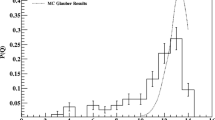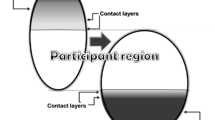Summary
A large stack of emulsion has been exposed in the 4.3 GeV π- beam of the Berkeley Bevatron. 317 K+ and 96 K- stopping in the stack have been observed; 184 K+ and 66 K- have been followed back to an originating star made by a beam π-. The origins of K- are larger than those of K-, as far as the numbers of black and grey prongs are concerned, and the emission of the K- is more concentrated in the forward direction than that of the K+. Charged gS of moderate energy have been observed in the origin of K+; their frequency is 0.17 +0.120.36 per star. The mean free paths for production of K+ and K- of energy < 150 MeV in emulsion are (4 700± 1200) cm and (24000± 7000) cm respectively. The majority of the K+ stopping in the stack are probably produced in secondary collisions in the nucleus of pions resulting from the first impact of the incoming π- A larger fraction of the K- is probably produced in the first collision. Approximate values of the production cross-sections of strange, particles by the collisions of 4.3 GeV π- with nucleons can be deduced from the study of suitably selected small origins of K+ and K-. The cross-section for the production of K+ is ∼ 0.7 mb. For K-, it is probably ≥ 0.3 mb. It, thus appears that as the pion energy increases from 1 to 4 GeV, there is no pronounced increase in the total cross-section for strange-particle production. The K K production becomes a substantial fraction of the total, and the direct hyperon production probably remains about constant or decreases.
Riassunto
Un grosso pacco di emulsioni è stato esposto al fascio di π- di 4.3 GeV del bevatrone di Berkeley. Si sono osservati 317 K+ e 96 K- arrestati nel pacoo. 184 K+ e 66 K- sono stati seguiti all’indietro fino a una Stella originaria prodotta da uno dei π- del fascio. Le origini dei K+ sono più ampie di quelle dei K- per quanto riguarda il numero di rami neri e grigi e l’emissione dei K- è più concentrata in avanti di quella dei K-. All’origine dei K+ si sono osservati gS carichi di moderata energia; la loro frequenza è 0.17 0.12-0.06 per Stella. I cammini liberi medi per la produzione di K+ e K- di < 150 MeV in emulsione sono rispettivamente ({dy4700} ±1200) cm e (24000 ±7000) cm. La maggioranza dei K+ arrestati nel pacco sono probabilmente prodotti in collisioni nucleari secondarie dei pioni risultanti dal primo urto dei π- incidenti. Una frazione maggiore dei K- è probabilmente prodotta nella prima collisione. Valori approssimati delle sezioni d’urto di produzione di particelle strane nella collisione dei π- di 4.3 GeV coi nucleoni si possono dedurre dallo studio di ristrette origini di K+ e K- opportunamente scelte. La sezione d’urto per la produzione di K+ è ∼ 0.7 mb. Per i K- è probabilmente ≥ 0.3 mb. Appare pertanto che, crescendo l’energia dei pioni da 1 a 4 GeV, non si ha un aumento pronunciato della sezione d’urto totale per la produzione di particelle strane. La produz one K-K risulta essere una sostanziale frazione del totale e la produzione diretta di iperoni resta probabilmente costante o decresce.
Similar content being viewed by others
References
G. Maenchen, W. M. Powell, G. Saphir andR. W. Wright:Phys. Rev.,99, 1619 (1955).
M. Schein, D. K. Haskin andR. G. Glasser:Nuovo Cimento,3, 131 (1956).
B. F. Edwards, A. Engler, M. W. Friedlander andA. Z. Kamal:Nuovo Cimento,5, 1133 (1957).
A. Marques, N. Margem andG. A. B. Garnies:Nuovo Cimento,5, 290 (1957).
J. O. Clarke andJ. V. Major:Phil. Mag.,2, 37 (1957).
M. W. Friedlander, Y. Fujimoto, D. Keefe, M. G. K. Menon, M. Ceccarelli, M. Grilli, M. Merlin, A. Salandin andB. Sechi:Suppl. Nuovo Cimento,4, 428 (1956).
K. W. Birge, D. H. Perkins, J. R. Peterson, D. H. Stork andM. N. Whitehead:Nuovo Cimento,4, 834 (1956).
M. Ceccarelli : Private communication.
N. N. Biswas, L. Ceccarelli-Fabbrichesi, M. Ceccarelli, K. Gottstein, N. C. Varshneya andP. Waloschek:Nuovo Cimento,5, 123 (1957).
M. Baldo-Ceolin, M. Cresti, N. Dallaporta, M. Grilli, L. Guerriero, M. Merlin, G. A. Salandin andG. Zago:Nuovo Cimento,5, 402 (1957).
G. Costa andG. Patergnani:Nuovo Cimente,5, 448 (1957).
G. Cocconi, G. Puppi, G. Quareni, A. Stanghellini:Nuovo Cimento,5, 172 (1957).
W. Alles, N. N. Biswas, M. Ceccarelli andT. Crussard: in print.
J. E. Lannutti, W. W. Chupp, G. Goldhaber, S. Goldhaber, E. Helmy andE. L. Iloff:Phys. Rev.,101, 1617 (1956).
W. H. Barkas, W. F. Dudziak, P. C. Giles, H. H. Heckman, F. W. Inman, C. J. Mason, N. A. Nichols andF. M. Smith:Phys. Rev.,105, 1417 (1957).
W. W. Chupp, S. Goldhaber, W. R. Johnson andF. Webb:Suppl. Nuovo Cimento,4, 359 (1956) (Pisa Conference).
J. Crussard, V. Fouché, J. Hennessy, G. Kayas, L. Leprince-Ringuet, D. Morellet andF. Renard:Nuovo Cimento,3, 731 (1956).
D. F. Falla, M. W. Friedlander, F. Anderson, W. D. B. Greening, S. Limentani, B. Sechi-Zorn, C. Ceenigoi, G. Iernetti andG. Poiani:Nuovo Cimento. 5, 1203 (1957).
M. M. Block:Phys. Rev.,101, 796 (1956).
G. E. A. Fialho:Phys. Rev.,105, 328 (1957).
G. Maenchen:Thesis UCRL, 3730 (1957).
F. Wikner:Thesis UCRL, 3639 (1957).
T. F. Hoang: Private communication.
M. Gell-Mann andA. Pais:Phys. Rev.,97, 1387 (1955).
K. M. Case:Phys. Rev.,103, 1449 (1956).
A. Pais andO. Piccioni:Phys. Rev.,100, 1487 (1955).
R. Levi-Setti:7th Rochester Conference (1957).
R. G. Glasser:7-th Rochester Conference (1957).
E. J. Lofgren undW. W. Chupp: Private communication.
A. I. Nikishow:Zurn. Exp. Theor. Fiz.,30, 990 (1956).
W. B. Fowler, R. P. Shutt, A. M. Thorndike andW. L. Whittemore:Phys. Rev.,98, 121 (1955).
Author information
Authors and Affiliations
Rights and permissions
About this article
Cite this article
Besson, C., Crussard, J., Fouche, V. et al. Production of strange particles by 4.3 GeV π- in emulsion. Nuovo Cim 6, 1168–1188 (1957). https://doi.org/10.1007/BF02747399
Received:
Published:
Issue Date:
DOI: https://doi.org/10.1007/BF02747399




